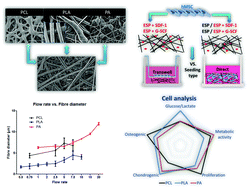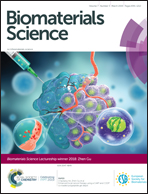Biological activity of human mesenchymal stromal cells on polymeric electrospun scaffolds†
Abstract
Electrospinning provides a simple robust method to manufacture scaffolds for tissue engineering applications. Though varieties of materials can be used, optimization and biocompatibility tests are required to provide functional tissue regeneration. Moreover, many studies are limited to 2D electrospun constructs rather than 3D templates due to the production of high density packed fibres, which result in poor cell infiltration. Here, we optimised electrospinning parameters for three different polymers: poly(ε-caprolactone) (PCL), polylactic acid (PLA) and poly(ethylene oxide terephthalate)/poly(butylene terephthalate) (PA) copolymers. Human mesenchymal stromal cells (hMSCs) were cultured on scaffolds for 14 days to study the scaffolds’ biocompatibility and their multi-lineage differentiation potential or maintenance of stemness in the absence of chemical stimuli. For all scaffolds, a high and stable metabolic activity was measured throughout the culture time with a high proliferation rate compared to day 1 (PCL 5.8-, PLA 4-, PA 4.9-fold). The metabolism of hMSCs was also measured through glucose and lactate concentrations, showing no cytotoxic levels up to 14 days. Total glycosaminoglycan (GAG) production was the highest in PA electrospun scaffolds. When normalized to DNA, GAG production was the highest in PLA and PA scaffolds. All scaffolds were prone to differentiate to an osteogenic lineage, with PCL providing the highest alkaline phosphatase and collagen type Ia gene upregulation. As PA had the most stable fibre formation, it was chosen as a template to further incorporate stromal cell-derived factor-1 (SDF-1) and granulocyte colony-stimulating factor (G-CSF), and stimulate higher hMSC infiltration. These scaffolds provided significantly higher hMSC infiltration than normal PA scaffolds. In conclusion, our optimized biocompatible electrospun scaffolds have shown promising regulation of hMSC fate. When combined with migratory stimulating cytokines, these scaffolds may overcome the known challenges of poor cellular infiltration typical of micro- and nano-fibrillary random meshes.



 Please wait while we load your content...
Please wait while we load your content...